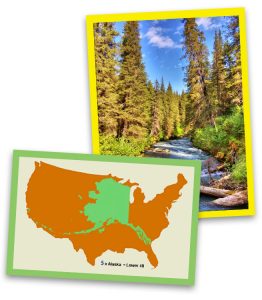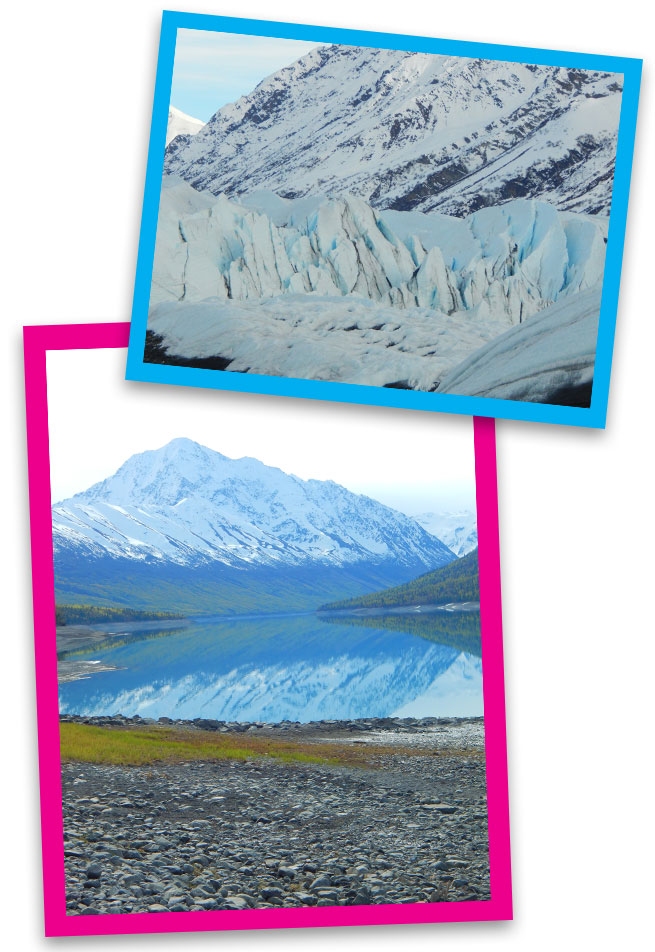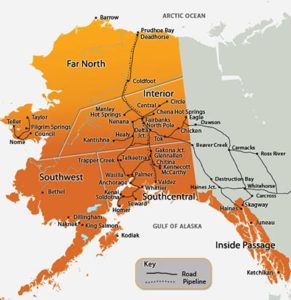Alaska Profile
Alaska is a huge and incredibly diverse state full of rugged beauty. While winters are cold and dark, summers are moderate, full of sun, lush green forests, and wildlife. Within this beautiful land is a great deal of spiritual need. Alaskans are (for the most part) rugged and independent, making ministry challenging. Thirst Missions is very excited to bring groups to The Last Frontier to work alongside local churches to bring the love of Christ to the people in very practical ways.
FACTS & FIGURES
Location: North America, northwest of Canada

Area: 663,000 square miles (larger than Texas, California, Utah, Kansas, and Florida combined)
Largest City: Anchorage, 300,950
State Population: 737,259
Coastline: 33,904 miles (Florida is second with 8,400 miles)
Climate: 60-80 highs in summer, 40-50 lows. Alaska has everything from a temperate oceanic climate to arctic tundra. Anchorage is considered a subarctic climate.
Terrain: Everything from rugged coastlines to tundra, woods, and the highest mountains on the continent.
Elevation Extremes: 0 to 23,320 feet (coastline to Mt. McKinley)
Natural resources: Oil and gas, timber/forestry products, commercial fishing, wildlife
Geography note: By square miles Alaska is 1/5 as large as the lower 48. If you lay Alaska on a map of the US, the Inside Passage reaches to the East Coast and the Aleutian Islands stretch to the West Coast.
ALASKA OVERVIEW
- Outsiders first discovered Alaska in 1741 when Danish explorer Vitus Jonassen Bering sighted it on a voyage from Siberia.
- Russian whalers and fur traders on Kodiak Island established the first settlement in Alaska in 1784.
- In 1867 United States Secretary of State William H. Seward offered Russia $7,200,000, or two cents per acre, for Alaska. Many Americans called the purchase “Seward’s Folly.”
- Joe Juneau’s 1880 discovery of gold ushered in the gold rush era.
- In 1926 13-year-old Bennie Benson from Cognac, Alaska designed the state flag.
- In 1943 Japan invaded the Aleutian Islands, which started the One Thousand Mile War, the first battle fought on American soil since the Civil War.
- Alaska officially became the 49th state on January 3, 1959.
- Alaska’s most important revenue source is the oil and natural gas industry. Alaska accounts for 25% of the oil produced in the United States.
- Prudhoe Bay, on the northern Alaskan coast, is North America’s largest oil field.
- The Trans-Alaska Pipeline moves up to 88,000 barrels of oil per hour on its 800 mile journey to Valdez.
- The state of Rhode Island could fit into Alaska 425 times.
- The fishing and seafood industry is the state’s largest private industry employer.
- Most of America’s salmon, crab, halibut, and herring come from Alaska.
- The term Alaska native refers to Alaska’s original inhabitants including Aleut, Eskimo, and Indian groups.
- The wild forget-me-not is the official state flower, the willow ptarmigan is the official state bird, and the Sitka spruce is the official state tree.
- Dog mushing is the official state sport.
- The state motto is North to the Future.
- Gold is the official state mineral. It was named the state mineral in 1968.
- Alaska has been called America’s Last Frontier.
- Every four years Alaskans elect a Governor and a Lieutenant Governor to four-year terms.
- Alaska’s Constitution was adopted in 1956 and became effective in 1959 making it the 49th state.
- Nearly one-third of Alaska lies within the Arctic Circle.
- The Alaska Highway was originally built as a military supply road during World War II.
- The state boasts the lowest population density in the nation.
- Alaska is a geographical marvel. When a scale map of Alaska is superimposed on a map of the 48 lower states, Alaska extends from coast to coast.
- The state’s coastline extends over 6,600 miles.
- The Tongass National Forest is the largest national forest in the United States.
- 17 of the 20 highest peaks in the United States are located in Alaska.
- At 20,320 feet above sea level, Mt. McKinley, located in Alaska’s interior, is the highest point in North America.
- The state’s largest city is Anchorage; the second largest is Fairbanks.
- The Alaska Range is the largest mountain chain in the state. It covers from the Alaska Peninsula to the Yukon Territory.
- In 1915 the record high temperature in Alaska was 100 degrees Fahrenheit at Fort Yukon; the record low temperature was -80 degrees Fahrenheit at Prospect Creek Camp in 1971.
- The Alaskan malamute sled dog is strong and heavily coated. It was developed as a breed by a group of Eskimos named the Malemiuts.
- Alaska’s name is based on the Eskimo word Alakshak meaning great lands or peninsula.
- When the sun’s rays strike the Earth’s upper atmosphere, they cause gases there to glow like a florescent light. This reaction is called the aurora borealis (northern lights) and can be seen an average of 243 days a year in Fairbanks.
ALASKA BY THE NUMBERS

663,000 – Alaska’s size in square miles (Alaska is larger than Texas, California, Utah, Kansas, and Florida combined)
100+ – Number of languages spoken in Anchorage Public School District (about the same as Los Angeles Unified)
50% – Anchorage students who are non-Caucasian
16 – People living in Manhattan if New York had same population density as Alaska (Manhattan has 1.62 million residents)
2,000 – Number of miles salmon swim up the Yukon River
1,150 – Miles run in the Iditarod dog sled race
100,000+ – Number of glaciers in Alaska
50% – Percentage of world’s bald eagles that live in Alaska
20,320 – Height of Denali in feet – the tallest point in North America
3 Million – Number of natural lakes in Alaska
1,600+ – Hours of daylight in the world’s longest day in Barrow, Alaska, where the sun doesn’t set from May 10 through August 2
4 to 1 – Ratio of lakes to people in Alaska




